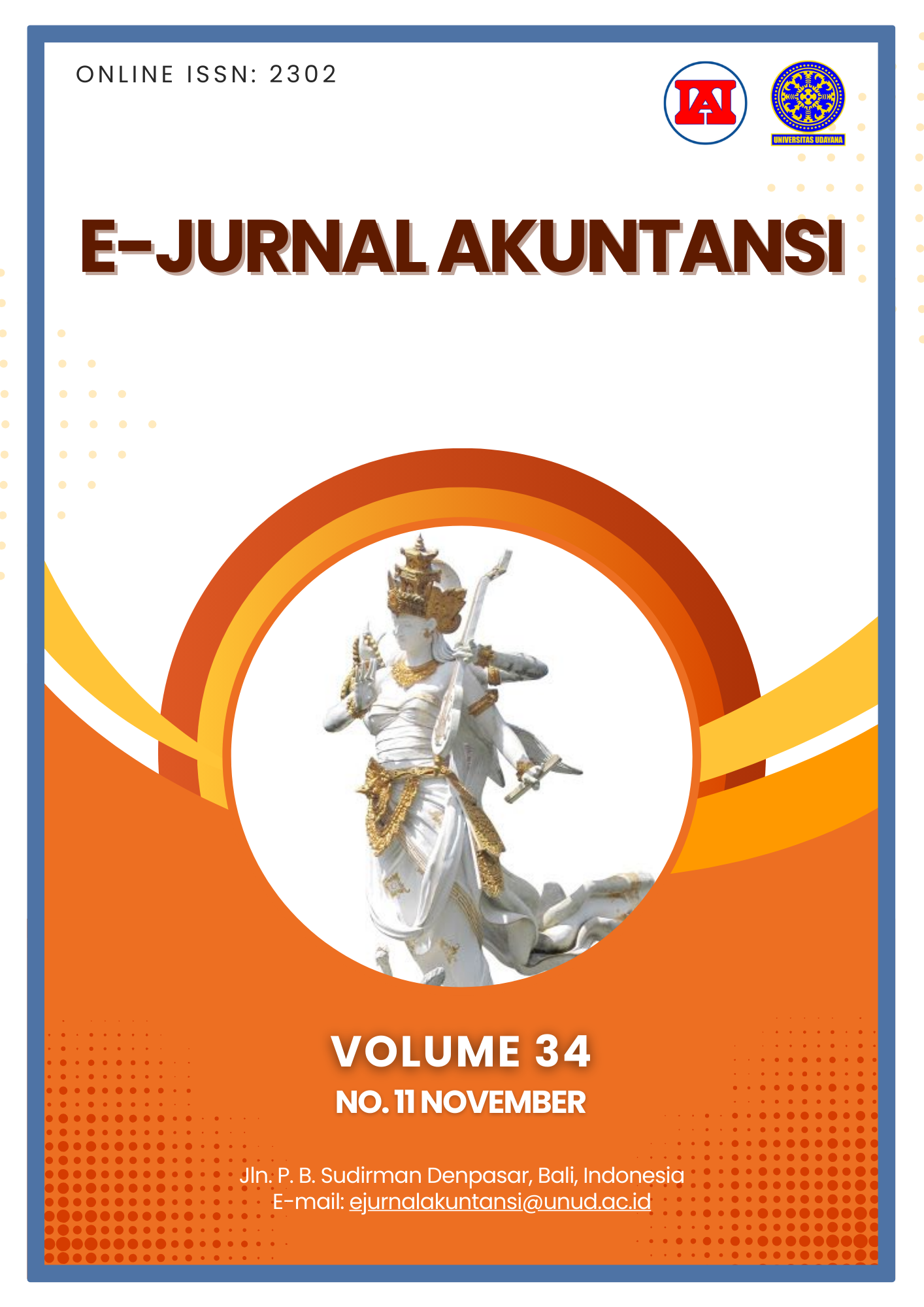Assessing User Perceptions of Tax Audit Desktop Applications: A Technology Acceptance Model (TAM) Perspective
Abstract
The Directorate General of Taxes (DGT) has undertaken a digital transformation initiative by introducing the Desktop Pemeriksaan (Derik) application to enhance the effectiveness and efficiency of tax audits. This study aims to evaluate the performance of the Derik application from the perspective of its users, utilizing the Technology Acceptance Model (TAM) as the theoretical framework. A mixed-methods approach was employed, adopting a concurrent triangulation design to integrate qualitative and quantitative data, thereby providing a comprehensive understanding of user perceptions. The quantitative data were collected through a survey involving 1,859 respondents, while qualitative insights were gathered through in-depth interviews with eight informants. The interviews explored key aspects such as ease of use, perceived benefits, and challenges encountered by users. Data analysis was conducted using descriptive statistical methods for the quantitative findings and thematic analysis for the qualitative data. The results indicate that while the Derik application meets the criteria for perceived ease of use and perceived usefulness, several constraints hinder its optimal utilization. Based on user feedback, this study offers practical recommendations for improving the application’s functionality in future iterations. The findings contribute to the literature by providing actionable insights and serve as a valuable reference for DGT in advancing the development of the Derik application.
Downloads
References
Atayah, O. F., & Alshater, M. M. (2021). Audit and tax in the context of emerging technologies: A retrospective analysis, current trends, and future opportunities. The International Journal of Digital Accounting Research, 95–128. https://doi.org/10.4192/1577-8517-v21_4
Chalu, H., & Mzee, H. (2018). Determinants of tax audit effectiveness in Tanzania. Managerial Auditing Journal, 33(1), 35–63. https://doi.org/10.1108/MAJ-06-2016-1390
Darono, A., & Pratama, A. (2022). Tax audit in the era of big data: the case of Indonesia. Journal of Tax Administration, Vol 7:2. https://www.researchgate.net/publication/366963083
Davis, F. D. (1986). A technology acceptance model for empirically testing new end - user information systems: theory and results. Ph. D. Dissertation.
Davis, F. D. (1989). Perceived Usefulness, Perceived Ease of Use, and User Acceptance of Information Technology. MIS Quarterly, 13(3), 319. https://doi.org/10.2307/249008
DJP. (2020). Manual Book Desktop Pemeriksaan. DirektoratJenderalPajak.
DJP. (2022). Laporan Tahunan DJP 2022. https://www.pajak.go.id/id/laporan-tahunan-2022
Hesami, S., Jenkins, H., & Jenkins, G. P. (2024). Digital Transformation of Tax Administration and Compliance: A Systematic Literature Review on E-Invoicing and Prefilled Returns. Digital Government: Research and Practice, 5(3), 1–20. https://doi.org/10.1145/3643687
Kalpande, S. D., & Toke, L. K. (2023). Reliability analysis and hypothesis testing of critical success factors of total productive maintenance. International Journal of Quality & Reliability Management, 40(1), 238–266. https://doi.org/10.1108/IJQRM-03-2021-0068
Marlisza, D., & Yulianti. (2022). 11417-38542-1-PB (3). Journal of Applied Business and Economic. https://journal.lppmunindra.ac.id/index.php/JABE/article/view/11417/4790
Munawara, M., & Ramlah, ST. (2021). Penerapan E-Billing dalam Persepsi Kemudahan Penggunaan. Management and Accounting Research Statistics, 1(2), 32–40. https://doi.org/10.59583/mars.v1i2.12
Nuryanah, S., Siregar, S. V. N. P., Arifin, I., & Sofyan, L. (2024). Taxpayers’ Perceptions of a New Digital Tax Return Feature: A Case Study in Indonesia. International Journal Of Ebusiness And Egovernment Studies, 16(1), 6–54. https://doi.org/10.34111/ijebeg
Perangin-angin, W. A., Respati, A. D., & Kusumawati, M. D. (2016). Pengaruh Perceived Usefulness DAN Perceived Ease Of Use Terhadap Attidude Toward Using E-Faktur. Jurnal Riset Ekonomi Dan Manajemen, 16(2), 307. https://doi.org/10.17970/jrem.16.1602010.ID
Putra, A. A. G. E. S., Mahyuni, L. P., & Putra, A. A. M. S. (2021). Menakar Penerimaan Wajib Pajak atas e-Bupot dengan Pendekatan Technology Acceptance Model. Jurnal Riset Akuntansi & Perpajakan (JRAP), 8(02), 1–15. https://doi.org/10.35838/jrap.2021.008.02.12
Rahmawati, A., Novita, D., & Pradesan, I. (2022). Analisis Penerimaan E-Tax Ditjen Pajak Kota Palembang Menggunakan Technology Acceptance Model (TAM). JATISI (Jurnal Teknik Informatika Dan Sistem Informasi), 9(2), 1330–1342. https://doi.org/10.35957/jatisi.v9i2.2519
Ripol-Saragosi, L., & Gomeleva, E. (2021). Application of digital tools to enhance tax administration processes. SHS Web of Conferences, 106, 01024. https://doi.org/10.1051/shsconf/202110601024
Sabriady, N. F. S., Syuhada, N. A., & Awalya, A. S. (2023). Ada Apa dengan Kualitas Audit dalam Menggunakan Teknologi Informasi di Indonesia? Indonesian Journal of Taxation and Accounting, 91–102. https://doi.org/10.61220/ijota.v1i2.2023c1
Saunders, M. N. K., Philip Lewis, & Adrian Thornhill. (2019). Research Methods for Business Students (8th Edition). Pearson International Content.https://bookshelf.vitalsource.com/reader/books/9781292208794.
Sekaran, U., & Bougie, R. (2019). Research Methods for Business - A Skill-Building Approach: Vol. Vol.7th (8th ed.). John Wiley & Sons Ltd. www.wileypluslearningspace.com
Shavitri, L. P. D., & Darma, G. S. (2020). Pengaruh Implementasi Kebijakan Pemeriksaan dan Forensik Digital terhadap Kualitas Pemeriksaan dan Keberhasilan Penerimaan Pajak. E-Jurnal Akuntansi, 30(10), 2682. https://doi.org/10.24843/EJA.2020.v30.i10.p19
UU KUP. (2007). Undang-Undang Ketentuan Umum Perpajakan. Negara Indonesia.
Venkatesh, V., & Bala, H. (2008). Technology Acceptance Model 3 and a Research Agenda on Interventions. Decision Sciences, 39(2), 273–315. https://doi.org/10.1111/j.1540-5915.2008.00192.x
Venkatesh, V., & Davis, F. D. (2000). A Theoretical Extension of the Technology Acceptance Model: Four Longitudinal Field Studies. Management Science, 46(2), 186–204. https://doi.org/10.1287/mnsc.46.2.186.11926
Winahyu, L. V., & Nuryanah, S. (2024). Compliance Risk Management (CRM) Ditinjau dari Persepsi Pengguna. E-Jurnal Akuntansi, 34(6). https://doi.org/10.24843/eja.2024.v34.i06.p03

This work is licensed under a Creative Commons Attribution-ShareAlike 4.0 International License.

















